New Vrindaban’s Old Log Cabin and the Brick House
The Old Log Cabin and The Brick House
The New Vrindaban Advocacy Sanga met with Jaya Krsna prabhu on Tues. July 5, 2014. One of the topics that came up was the recent removal of the old log cabin that used to sit just off the road across from Srila Prabhupada’s Palace of gold. It was made of massive, thick logs and, at one time, was an attractive remnant from the Limestone area’s past. Over the years, there have been various additions and subtractions made on the cabin. Acting on inquiries from residents of the community, who noticed with some surprise that the cabin was being dismantled, the Advocacy Sanga brought up the topic with Jaya Krsna on behalf of the residents.
According to Jaya Krsna, although the log cabin has been taken down, it will be re-used as a temple for Krsna for the devotees living in the area of Yudhisthira’s land.
Jaya Krsna explained, “There are a few reasons why the log cabin has been removed. First of all (but not necessarily in order of importance) New Vrindaban has been doing a lot of promotion over the last two years to bring back visitors and buses to Srila Prabhupada’s Palace of Gold. This includes TV spots in Pittsburgh, ads in tourism magazines, as well as distributing flyers to a wider area than we have done in a long time.
to bring back visitors and buses to Srila Prabhupada’s Palace of Gold. This includes TV spots in Pittsburgh, ads in tourism magazines, as well as distributing flyers to a wider area than we have done in a long time. As a result, we have experienced that more buses and tourists are coming. Our Palace parking lot is not big enough to accommodate all the vehicles. At the beginning of the season, two spaces for tour buses have already been realized.
Jaya Krsna went on, “Another reason concerns the history of this cabin. Some people thought that the cabin was a significant historic building, in which case we would not want to remove it, but rather have it certified and marked as such. However, after some research, Varsana Maharaj discovered that the cabin had been a church built in 1810, originally in Limestone, but had been moved two times prior to settling where it was for some years now, across from the Palace. It was not at all connected with the historic Wetzel family, as many people thought – a family who had settled the current area of New Vrindaban back in frontier days. In addition, when Yudhisthira recently approached the Marshall County Historical Society, they showed no interest, nor did they give any historical significance to the cabin.”
According to Jaya Krsna, the third reason for removing the cabin is related to Varsana Maharaj’s Govardhana Hill and Sri Sri Radha Gopinath Mandir project. There have been plans in place for many years to construct this small replica of Vrindavan Dhama in New Vrindaban in the area of Govardhana Hill, a region which includes the log cabin as well as the brick house (Kirtanananda Swami’s old house). Just a couple of years ago, when some professsors from WVU did research work on the topic of holy places of pilgrimage in New Vrindaban, they recommended that, for optimum effectiveness, there should be no buildings obstructing the view or the access between the Palace and Govardhana Hill.
This is a fact which has already been proven at the recent July 4 festival. Visitors were seen leaving their Palace tour, and then walking directly up to the Sri Sri Radha Gopinatha Mandir, which was now clearly visible due to the removal of the cabin.
“Finally,” Jaya Krsna reminded everyone, “the decision about the log cabin was discussed at the April joint Board meetings and then presented to the community during the community dialog that same weekend.
The Brick House
The brick house, still standing next to where the log cabin was situated, originally belonged to non-devotees, but was bought by the community in 1980, and ultimately became Kirtanananda Swami’s residence for some years, with a men’s asrama downstairs. After he left the community in 1994, the brick house was used as living quarters for one family upstairs, and offices for the Palace downstairs. But then, the house remained empty for many years and fell into disrepair. Eventually, there was a new roof put in, and the basement was gutted in order to eliminate the black mold, all in an effort to possibly make the house useful again. However, due to various changes in New Vrindaban at the time, the house was never again used to this date, and is now in even worse shape.
Jaya Krsna says that this house will also soon be taken down and partially re-used, in order to further clear that area for the Govardhana Hill project, which is meant to help fulfill the part of Srila Prabhupada’s vision for New Vrindaban as a place of pilgrimage.
Summer Harvest from the New Vrindaban Gardens
The last few weeks have been VERY busy in the gardens. We have had many new volunteers. A family from Maryland came to work and camp in the garden. Currently we have two volunteers from WWOOF (world wide opportunities on organic farms) that have been helping with our abundant harvest of green beans. The Roots & Shoots 4-H Cloverbud Club came and spent a day touring the gardens and picking flowers. The kids had a wonderful time and learned all about farming and flowers.
The first week of July we planted four varieties of squash. This is the last big planting until fall. Our sweet potatoes are looking great and the vines are filling in all the spaces in their beds. Twice a week we harvest herbs and greens for the temple (lettuce, kale, swiss chard, and arugula). This week brought us our first full sized red tomatoes and bitter melons. Our current pick list also includes red raspberries, peppers, beets, basil, oregano, cucumbers, cherry tomatoes, dill, and tons of green beans. Two of our local contract growers have been also making weekly deliveries or carrots and cilantro.
Both the Teaching Garden and the Garden of Seven Gates are bursting with beautiful flowers. The temple staff has been picking hundreds of marigolds for garlands and a variety of flowers for vases. As we move further into the summer harvest we hope to have more volunteers to continue to provide the community with a bounty of vegetables and flowers.
Srila Prabhupada Has “Many Ideas for New Vrindaban” and Hopes to “Develop Many New Vrindabans” – March 1969
Srila Prabhupada “Has Many Ideas for New Vrindaban” and Hopes to “Develop Many New Vrindabans” – March 1969.
From a series of letters written by Srila Prabhupada outlining his vision for New Vrindaban.
Thanks to Vanipedia for the source material.
———————————————————————-
My Dear Satyabhama,
Please accept my blessings. I am in due receipt of your letter dated Feb. 22, along with the Deities dress, and it was received by me just yesterday. I think due to my change of address it was delayed. Anyway, everyone here has very much appreciated the beautiful dresses you have sent for the Deity and today we are changing the dress by putting on your dress on the transcendental Body of the Deity.
I think I have replied your former letter also, which I hope you have received by this time, and I am so glad to learn that you are feeling very happy in New Vrindaban. The basic principle of our life in Vrindaban will be cow keeping. If we can keep cows sufficiently and grow our necessary foodstuffs, then we shall show a new way of life to your countrymen . . . completely spiritual life in healthy atmosphere in divine consciousness. And you will have ample opportunity to educate children and write books for them because there is sufficient matter for publishing such books from the Puranas, Mahabharata, Srimad-Bhagavatam, and many other allied literatures. There are thousands of ideal historical events, which if we can put with suitable pictures, it will be a great idea and people will like to have such literature. I have got many ideas for developing the new Vrindaban scheme and if Krishna gives me opportunity I may be able to show something very wonderful in your country. Unfortunately I have no money neither the richer section of your countrymen have taken any serious view of our movement. Otherwise there is more than sufficient money and if one or two men of your country gives a little attention, with this we can develop many New Vrindabans. We are not very much expensive; simply if we get the necessary money, we can play wonderful. Our only hope is books and literature. So we have to start press, and for that purpose, and publish varieties of books and literature for getting some financial help as well as propagating our mission. So as soon as I come to your place I shall give you all nice ideas you have asked for in your letter under reply. And I thank you very much for giving me all these ideas for our future activities. Please convey my blessings to all your God-brothers and God-sisters there, and especially our Syama dasi, I hope she is doing well.
So far keeping Deity in your separate house, I think there is no need for this. Because if you keep Him there, you have to take proper care, with aratis and attention, and thus divert attention from the Deity in the temple, and from chanting and so many other forms of service, like your writing and sewing, etc. So I think it best if everyone centers his attention on the Deity in the temple, and in that way the temple worship will pull on nicely. Of course, if the temple is unapproachable, or too far, or something like that, that is different thing, but if the temple is easily accessible then this is the best program—for all to go there and attend arati and kirtana etc.
No, I do not think you should give Jagannatha to small children because they will not take proper care and make offenses. In this country their parents do not give them proper example of worshiping the Deity with all respects. Just like in my childhood, I was seeing my father bowing down and offering respects to the Deity and I did the same on seeing him. But this is not done here, so it is better to take some care in giving Jagannatha out.
I hope you are all well,
Your ever well-wisher,
A.C. Bhaktivedanta Swami
New Vrindaban’s Transcendental Throwback Thursday – 07/10/14
New Vrindaban’s Transcendental Throwback Thursday – 07/10/14.
Each week we highlight an earlier era of ISKCON New Vrindaban.
This week’s challenge: There are at least a dozen recognizable faces in this photo. How many can you identify?
Extra credit: What’s the celebration and when was it?
What to do: Post your guesses on the “who, what, when, where & why” in the comment section at the New Vrindaban Facebook Page.
Technical stuff: We share a photo Thursday and confirm known details Sunday. Let’s keep it light and have a bit of fun!
Special request: If you have a photo showing New Vrindaban devotees in action, share it with us and we’ll use it in a future posting.
Upcoming New Vrindaban Summer Festivals
Spiritual Fun Coming Up This Summer in New Vrindaban:
Two Festivals and A Seminar:
1. Lord Jagannatha’s Ratha Yatra/Festival of the Chariots on Sat. July 19, 2014.
2. Then, the 4th Annual Pushpa Abhishek on Sat. July 26, 2014.
3. On Pushpa Abhishek weekend July 26/27, our esteemed guest His Grace Gauranga prabhu from ISKCON Chowpatty, Mumbai, will give seminars Sat. and Sun., speaking on “Lessons on Vaishnava Relationships” from Gaura Lila .
Lord Jagannath Snan Yatra @ New vrindaban
On this day, Jagannatha, Baladeva, and Subhadra allow Themselves to be bathed by all following the original tradition of worship at Jagannatha Puri. Our devotees as well as hundreds of local people enthusiastically assemble at the Jagannatha temple to perform abhisheka with Ganges water, milk, etc. This bathing goes on for a few hours in the midst of kirtanas glorifying Their Lordships and the chanting of the maha-mantra. Lord Jagannatha’s prasada is also offered to all visitors.
Lord Jagannatha’s pastimes are such that after snana-yatra, Jagannatha, Balarama and Subhadra become “sick”, and, so, must take “medicines” and “take rest” until they become “rejuvenated” enough to go for Ratha-yatra. When they are “sick”, they are offered bhoga containing medicinal herbs without the usual offerings.
Please click here for more photos
ECO-Vrindaban Board Meeting Minutes – 06/15/14
ECO-Vrindaban Board Meeting Minutes – 06/15/14.
Mission Statement: ECO-Vrindaban promotes a simple, sustainable lifestyle centered on the care and protection of cows, local food production and the loving service of Lord Krishna, as envisioned by Srila Prabhupada, the Founder-Acharya of ISKCON New Vrindaban.
Participating Members of the ECOV Board of Directors: Chaitanya Mangala, Madhava Gosh, Krpamaya, Navin Shyam, Anuttama and Ranaka.
Advisors present: Jaya Krsna
1. ECOV Documentary
WHEREAS: The ECOV Board wishes to support a film student who has been filming the New Vrindaban community.
RESOLVED: The Board authorizes $600 for a camera for Sabrina Jones with the condition that she does some filming of the garden and allows ECOV to keep the raw footage.
2. Rammed Earth Housing Request
A devotee family mentioned they are thinking of moving to New Vrindaban and expressed an interest in building a rammed-earth house to live in.
The ECOV board requires a formal proposal from the devotees interested in building the house in order to make a more informed response. Krpamaya will contact him regarding this.
3. Follow up on Radha Krsna Dasi from Montreal
WHEREAS: The ECOV Board wishes to engage Radha Krsna Dasi as a participant in its activities.
RESOLVED: The Board invites her as a guest to the next Joint Board Meeting.
4. ECOV President/General Manager
A committee has formed to recruit an ECOV President/General Manager. This committee consists of Navin Shyam, Chaitanya Mangala, Jaya Krsna and Ranaka.
5. INV/ECOV Dairy Processing
WHEREAS: The ECOV Board wishes to continue to support the ongoing local dairy production efforts in New Vrindaban.
RESOLVED: The Board agrees to adopt the dairy processing project and incorporate related expenses into the ECOV operations budget.
6. Ox Program Grant
INV has located and is using a teamster, Daivata dasa, who will be funded by a previously approved ECOV allocation.
Daivata dasa, the husband of Visvadhika dasi (homeopathist from Canada), is an accomplished North American teamster. He has experience with oxen and heavy equipment and was previously a long time New Vrindaban resident. He will be managing his time between working with the oxen and assisting Varsana Swami with heavy equipment.
7. INV Temple and Lodge Foundation Garden Beds
WHEREAS: The ECOV Board wishes to make the areas most visible to guests visiting the Temple more attractive.
RESOLVED: To complete the ongoing garden bed project, the Board authorizes an increase in the funding of the foundation garden beds project by $6,000.
Srila Prabhupada Sees Deity Worship in New Vrindaban as Being of “the Highest Standard” in ISKCON – December 1974.
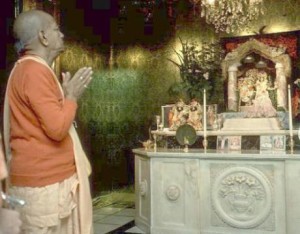
Srila Prabhupada greets Sri Radha Vrindaban Natha at the original New Vrindaban farmhouse – June 1976.
Srila Prabhupada Sees Deity Worship in New Vrindaban as Being of “the Highest Standard” in ISKCON – December 1974.
From a series of letters written by Srila Prabhupada outlining his vision for New Vrindaban.
Thanks to Vanipedia for the source material.
———————————————————————-
Bridesville, Canada
My dear Bahudak,
Please accept my blessings. I beg to acknowledge receipt of your letter dated Dec. 3, 1974 and have noted the contents.
The pictures of your newly installed Deities are very very nice. And you can name them Sri Sri Radha-Madan Mohan. The Deity worship should be done very carefully and nicely. Sri-vigraharadhana-nitya-nana, srngara-tan-mandira-marjanadau, yuktasya bhaktams ca niyunjato’pi, vande guroh sri-caranaravindam. You should make sure that there is nice arati program; six arati daily at least. You should make sure that there is nice fresh, clean dress every morning, nice bathing ceremony every morning, nice offerings of prasadam. You should see that the Deity is tended for and cooked for only by the duly second initiated brahmanas. The Deity should have nice flowers everyday etc., etc. You should try to bring Them up to the highest standard, such as we have in Los Angeles or New Vrindaban. Sri Sri Radha-Madan Mohan have kindly descended in Their arca vigraha form now you must receive Them with that consciousness. And by serving Them you will all develop pure love of Krsna.
Thanking you for helping me in my mission. Occasionally send me report of how things are going on there. I hope this meets you in good health.
Your ever well-wisher,
A.C. Bhaktivedanta Swami
ACBS/ps
New Vrindaban Garden Manager Takes Step Closer to Sustainable Vision
New Vrindaban Garden Manager Takes Step Closer to Sustainable Vision
By Madhava Smullen
Back when she started visiting New Vrindaban at age sixteen, admiring the Rose Gardens at Prabhupada’s Palace and thinking it would be her dream job to work there, Kacey Orr could never have predicted how all the pieces would fall into place.
When her grandfather’s farm in Triadelphia, West Virginia was cut into pieces to make way for the Interstate, farming skipped a generation as her father became a teacher. Kacey, too, seemed destined for a different life, running her own salon. But she felt unfulfilled, and in the late 2000s moved to farming full-time on her family’s farm, and selling her organic produce at local Farmer’s markets in Wheeling and Moundsville.
Her success allowed her to go back to West Liberty University to finish her B.A., for which she wrote a comparative geographical study of Vrindavana, India, and New Vrindaban, West Virginia in 2011. She also began visiting the spiritual community more regularly again, and made friends amongst the community members.
Then at a farmers’ market, she met Madhava Gosh, an agriculturist at New Vrindaban since 1974. Impressed by the news coverage Kacey had gotten for competing in a national farming competition, he invited her to apply for an opening at the community.
Cutting down growing at her own farm to just what she needed for her family, Kacey became New Vrindaban’s full-time Garden Manager in March 2014.
Local food production was, of course, a major goal for New Vrindaban’s founder Srila Prabhupada, and was emphasized in the community from its inception in 1968 until 1979. But in the 1980s and ‘90s it began to taper off and then all but disappeared, until a smaller scale of farming was re-introduced in 1998 by the Small Farm Training Center.
Since 2014, ECO-Vrindaban, a non-profit organization, has been continuing and expanding the Training Center’s program. By caring for New Vrindaban’s forty-eight cattle, milking its eight dairy cows and developing sustainable agriculture, ECOV has been realizing Srila Prabhupada’s vision of self-suffiency and simple living for the community.
And now, as the organization brings in Kacey with her commitment and expertise, community members hope to get closer to that vision than they’ve been in a long time.
Kacey isn’t working alone: she’s gathered a staff of four local people with farm experience and a major interest in sustainability, including some ecology students. And they’re aided by volunteers including local children’s book author Marty Wach, Madhava Gosh as a consultant, and many other New Vrindaban devotees.
They have a lot of work to do. New Vrindaban has three gardens: the five-acre Garden of Seven Gates, the half-acre Teaching Garden, and a small meditation garden behind the temple.
“I have a completely new crew, and this is completely new ground for me,” says Kacey. “It took me years to figure out my ground on my own property. So this year is a lot about learning, exploring and figuring things out.”
It’s a lot about action, too. The garden crew have already put up eight-foot fences and smaller ground-level fences around both main gardens to keep out deer, rabbits, and groundhogs.
In the larger Garden of Seven Gates, they have either planted or are planning to plant during the summer one thousand sweet potatoes, 300 tomatoes, 200 peppers, and 50 basil, as well as squash, snap peas, shell peas, green beans, and organic soybeans for edamame.
Amongst these they’re also planting “cover crops” – plants that act like “green manure” to revitalize the soil – such as buckwheat, Daikon radishes and cowpeas.
“We’re also trying some new things to see what works well,” says Kacey. “There’s ornamental eggplant, large organic edible sunflowers, and quinoa is something I’m very interested in too. It works well at high elevation, can handle drought, and is a whole grain.”
In the Garden of Seven Gates there are also grapes and perennial berries such as raspberries, blackberries, gooseberries, bush cherries, goji berries, honeyberries, and blueberries.
Meanwhile in the Teaching Garden, which is planned as an apothecary garden for medicinal herbs, the crew is planting many flowers for the presiding Deities of New Vrindaban, Sri Sri Radha-Vrindabanchandra, including lilacs, hydrangeas, butterfly bushes, mock-oranges, peonies, zinnias and marigolds.
Finally, in the meditation garden near the temple, there are culinary herbs like oregano, basil, rosemary, sweet sicily and mint.
“It’s an enclosed area, the sort of place you can go to sit and chant your japa, if you want to be outside but undisturbed,” says Madhava Gosh.
For even more food production, Gosh explains, ISKCON New Vrindaban has introduced the concept of contract growing – that is, the temple pays people to grow a particular crop. Currently devotees and other locals including a microbiology professor and a full-time farmer are growing carrots, zucchini, brussel sprouts, broccoli, paste tomatoes, and cilantro for ISKCON New Vrindaban.
While only planting is being done now and harvesting will mostly come later in the season, there are a few crops ready now – asparagus is being harvested, and marigolds will be ready to pick by mid June.
What’s more, Kacey says she’s trying to do a lot of succession planting, spacing her planting at two week or one month intervals “so that we have a steady flow of vegetables, rather than one giant wave.”
In addition, three high tunnel greenhouses, planned for going up before the end of the year, will “extend the seasons,” allowing the gardeners to plant crops ahead of time and then harvest them throughout the winter.
“The goal is to supply all the veggies for the thirty or so people being fed by the temple kitchen during the week,” says Madhava Gosh. Gardeners and cooks will work together to ensure that fresh, locally grown vegetables are also available for the Deity kitchen and Govinda’s restaurant.
Kacey hopes to be able to reach this goal, and be “at least producing some food and flowers year around,” within the next five years. Meanwhile the 200 fruit trees the crew planted this spring should also see a yield.
“It takes a while for fruit trees to produce, but when we hit the five-year mark, we should be producing much of our own fruit,” says Kacey.
Despite the challenges of weather and a new environment, Kacey is glad to be working at New Vrindaban, with its strong support staff and pre-existing infrastructure.
“I’m so lucky to have this opportunity,” she says. “To have this kind of environment and infrastructure, and to work with a community that has a sustainability goal and a long-term plan.”
There’s always plenty to do towards this plan in the community gardens, no matter the season, and Kacey is always eager for people to volunteer as much – or as little – as they’d like. To make your contribution, contact her at korr.ecov@gmail.com or, just find her in the gardens!
New Vrindaban’s Transcendental Throwback Thursday – 07/03/14
New Vrindaban’s Transcendental Throwback Thursday – 07/03/14.
Each week we highlight an earlier era of ISKCON New Vrindaban.
This week’s challenge: There are more than 50 devotees in this photo. How many can you identify?
Extra credit: What’s the celebration?
What to do: Post your guesses on the “who, what, when, where & why” in the comment section at the New Vrindaban Facebook Page.
Technical stuff: We share a photo Thursday and confirm known details Sunday. Let’s keep it light and have a bit of fun!
Special request: If you have a photo showing New Vrindaban devotees in action, share it with us and we’ll use it in a future posting.
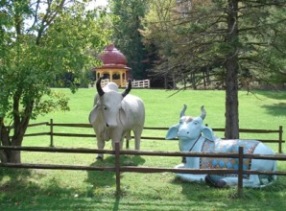
Welcome to Brijabasi Spirit
Thank you for taking the time to visit the New Vrindaban community blog. Think of visiting our blog as making a virtual pilgrimage.
Hare Krishna Hare KrishnaKrishna Krishna Hare Hare
Hare Rama Hare Rama
Rama Rama Hare Hare
"May cows stay in front of me; may cows stay behind me; may cows stay on both sides of me. May I always reside in the midst of cows."
Hari Bhakti-vilas 16.252



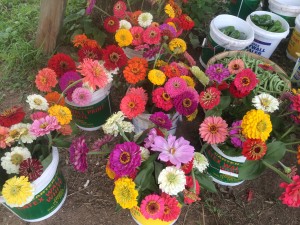
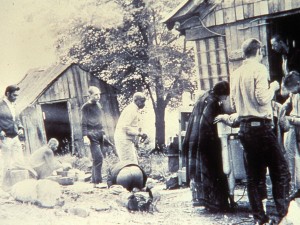
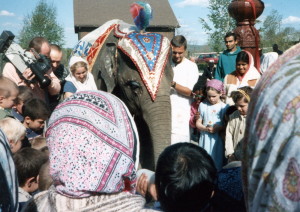
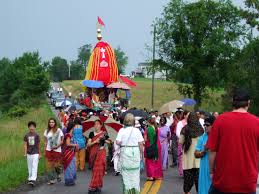


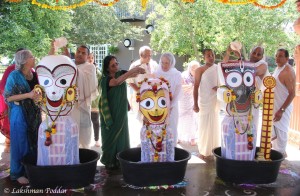
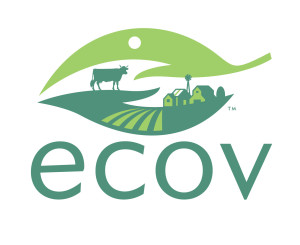
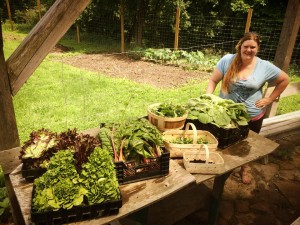
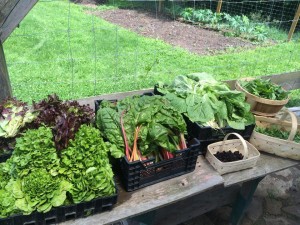
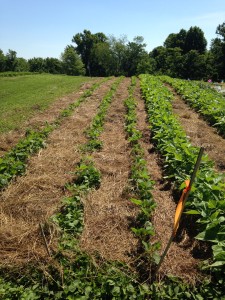
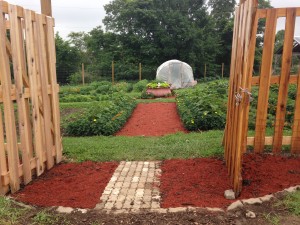
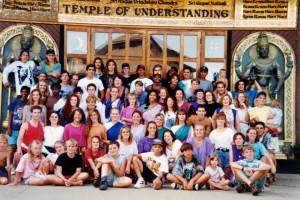




Recent Comments